Part 7: British Railways - The Diesel Era (continued)
The Diesel Multiple Units
1) The 'yellow diamond' 79xxx Types
BR Diesel Multiple Units (DMUs) had a wide variety of coupling codes for enabling several units with the same code to be couple together and controlled by one driver. These codes differed to those used for locomotives. The two most common DMU coupling codes were 'blue square', which was to become the nominal standard, and 'yellow diamond'. Only units with the same code could couple together and work in multiple. The difference between the two lay in the control systems, in a nutshell the way equipment along the length of the train was wired and operated.
Apart from on the Southern Region, DMUs were either diesel-mechanical or diesel-hydraulic The former predominated and on these drivers had to change gear. Most DMUs had two engines per powercar and the general rule was one power car and one trailer car, thus a two-car unit would be power / trailer, a three-car unit would be power / trailer / power and so on. Engines were either BUT or Rolls-Royce. BUT being the predominant type. BUT (British United Traction) was a Leyland / AEC consortium set up to manufacture railcar equipment and trolleybuses. Most BUT engines were 6-cylinder horizontal types of 150bhp but others were 180bhp, 230bhp and the Rolls-Royce offerings 238bhp. All the 'yellow diamond' DMUs used the 150bhp engines.
The first of the type to arrive at Cambridge did so in 1955, 20 November it is believed. These were Metropolitan-Cammell (Metro-Cammell) units E79047 / E79263 and E79051 / E79278. These sets came to Cambridge for timing trials on lines in the area and are known to have done so on the Mildenhall, Stour Valley and Bedford lines at least. Cambridge diesel depot did not open until September 1958 and it is thought the Metro-Cammells had a makeshift base at the former GNR engine shed, by then a wagon repair shop. These were the only examples of the type to be allocated to Cambridge but were always a common sight on services into Cambridge from Norfolk and Suffolk.
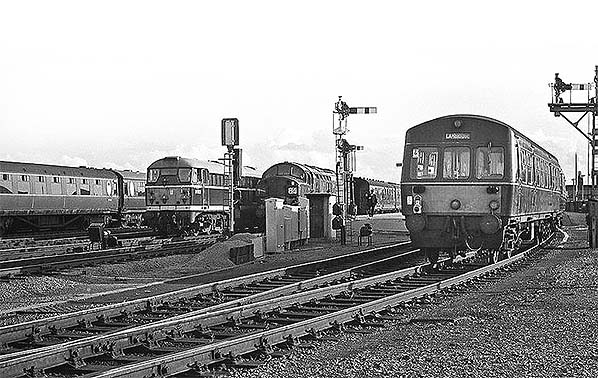
© Chris Burton
The Metro-Cammell 79xxx units were quite a rare breed. Only 36 units were built, all 2-car. The first seven went to Bury (Manchester) with the remainder going to East Anglia, including a few at Stratford, and were destined to spend their entire lives in these areas apart from a few trials in other areas and one set which ultimately entered departmental service. The Bury sets differed from the remainder in that they had first class accommodation. The Stratford units operated branches such as Romford - Upminster and Wickford - Southminster but could also appear on the North Woolwich, Maldon and Braintree branches. For a time they became well known for working a summer through Liverpool Street - Sheringham service, usually formed of three units coupled together.
These units were properly referred to as the Metro-Cammell Lightweights and their construction was more sturdy than that of the Derby Lightweights, the power cars actually weighed half a ton less than the equivalent vehicle of the latter. Quite infuriatingly, the Metro-Cammell Lightweights are today often misdescribed as Class 101s and sometimes by people who ought to know better. They were not 101s and differed in a number of ways to them. Apart from the obvious, the coupling code (101s were 'blue square'), there were a number of other differences. Driving method was the same but the controls differed, in particular the throttle control lever which was a different design and was mounted differently to the 'blue square' units which had Sharpes controls. The gear change lever also differed, being in appearance more like those found on tramcars.
Above in September 1964 we can see a Metro-Cammell 79xxx unit arriving at platform 6 with the 17:00 from Ipswich, due at 18:43. For a journey of some 54 miles, 103 minutes was hopelessly slow but we should remember that until 1967 the Cambridge - Ipswich line had many more stations than it did subsequently. Nevertheless, even today with modern trains it is not a particularly fast journey with around 80 minutes being the norm. On the left, is D6719 which had arrived with the 17:36 ex Liverpool Street and D5529 standing on the platform avoiding road. D5529, as 31111, survived in service until March 1983 when it suffered an engine explosion near Peterborough. It was eventually scrapped at Swindon works in 1986. Note the signals, including the colour-light, which had replaced the impressive bracket which once stood at the north end of the station.
Getting back to the DMU, the boxes below the outer windscreens were sockets for multiple unit jumper cables. The cables themselves were stowed in a cupboard in the cab and when being connected had to be done so in a certain order; this order being indicated by numbers, not visible above, beneath the sockets. Later, the cables were left in place in their sockets and dummy sockets were added to accommodate the free end of the cables when not in use. On the 101s and indeed other 'blue square' units, all this paraphernalia was located on the bufferbeam. One other visible difference and one which was peculiar to the 79xxx Metro-Cammells was the cowling below the bufferbeams.
One further difference could be seen in the cabs. Many readers will be familiar with the notice above the windscreens of the 'blue square' DMUs which stated 'Max speed 70 mph'.. On the Derby and Metro-Cammell 79xxx units this originally stated 65 mph. but for what reason is not known. They were well capable of exceeding this speed. Speeds of 65 or 70 mph might today seem something of a joke but it was adequate for the type of work DMUs of any type were intended for.
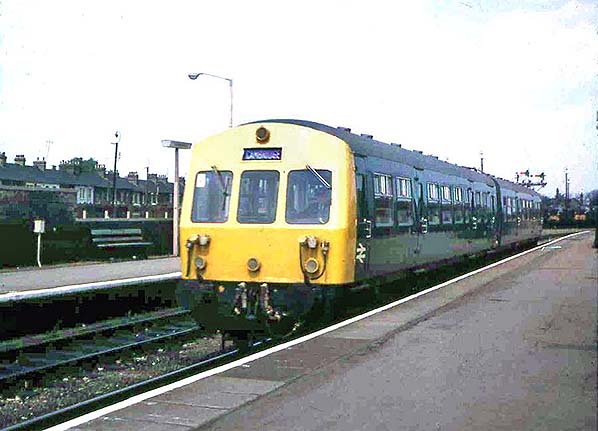
Photo by Stewart Ingram
Above we see an immaculate repainted Metro-Cammell 79xxx unit arriving at platform 5. No details are known but it is probably 1966/7 and the train is likely to have come from either Ipswich or Norwich. By this time the jumper cables were left on the cab fronts rather than being stowed in the cabs. The 'yellow diamond' coupling code can be seen on the bufferbeam. With the introduction of full yellow ends, the coupling code was placed on the cab front in a black square on some of these units and more commonly on the Derby Lightweights. Note that a windscreen wiper has been fitted to the secondman's side of the cab, although DMUs were rarely seen with more than one man in the cab by this time. No doubt passengers in the front seats appreciated it.
One criticism towards all of what we now call the first generation DMUs was that their technology was outdated even before the units were introduced. Broadly speaking this was true but did it really matter? The answer is probably no. The technology was proven and this enabled the units to go more or less straight into service and reliably so. This is precisely what they did. As we will see, the Metro-Cammell design very much influenced the way BR Derby works and others designed subsequent classes of DMU.
During the 1960s BR hatched a plan to rewire the 'yellow diamond' sets to make them compatible with the 'blue square' sets. However, the 'yellow diamonds' were by then very much a minority type and the line closures of the 1960s meant there was a surplus of DMUs. The 'yellow diamond' sets had therefore all been withdrawn from passenger service by 1969 having seen a mere 14 years service. They went to the scrapyard when they were fit enough for another thirty years service. One of the Metro-Cammell sets went into departmental service but, despite attempts to save it, it was finally scrapped in the 1980s. The set concerned was a power twin formed from E79047 and E79053, the former being one of the cars originally sent to Cambridge in 1955.
These early DMUs are considered as part of the 1955 Modernisation Plan although they slightly predated it; Derby Lightweights first appearing in 1954 in the Leeds / Bradford area. The Derby and Metro-Cammell Lightweight sets originally bore the BTC 'emaciated ferret' logo, officially on power cars only but it is known to have appeared on a few trailer cars too - presumably in error. The ferret logo also appeared on a few of the 'blue square' units; a photograph exists of it on a Cravens unit for example.
The Derby Lightweight units first appeared, as mentioned above, in 1954 in West Yorkshire. This batch was something of an oddity, having 125bhp engines and, as BR termed it, hydro-mechanical transmission. They were power-twins, so four engines per two-car unit and they used the same Lysholm-Smith torque converter as had been fitted to the LMS articulated unit and railbuses 29950 - 2. The eight 2-car sets comprising this batch had the rare 'red triangle' coupling code which appeared only on one other type, the Class 127. Unsuccessful for a number of reasons, the early Derby Lightweight batch was withdrawn in February 1964.
The next batches of Derby Lightweights were conventional diesel-mechanical units with 150bhp engines, two per power-car. There were 2-car and 4-car versions plus the pair of single cars for the Bletchley - Buckingham - Banbury Merton Street service. Much more numerous than the Metro-Cammells the Derby Lightweights were also much more widespread but did not work on the Southern and Western Regions under normal circumstances. There were also detail differences throughout the type; for example, those which worked in Cumbria had bars over door droplights for clearance reasons. Despite having elliptical roofs the interior ceilings were almost flat and this made the units appear deceptively wide internally.
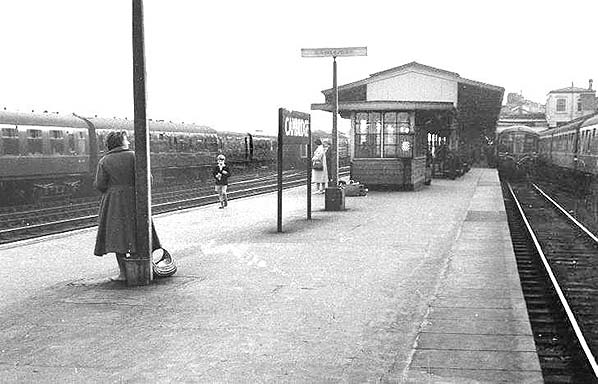
Photo from John Mann collection
The above images does not show the DMUs clearly but is included for its atmosphere. In the siding are various BR and Gresley carriages of both main line and suburban types while on platform 4 / 5 a BR blue enamel running-in board has been erected. The waiting shelters, of which there was one at each end of the station, were ghastly structures which deteriorated quite quickly. Considering they were so close to the canopy, which had seats beneath it, the shelters were really rather pointless. The date of the image is not known but is probably c1963. The people on the platform are typical of the time; the young boy in his shorts and the women in their overcoats. The wicker shopping basket was a very common type through the 1950s and 1960s with just about every housewife having one. In platform 5 lurks a Derby Lightweight DMU complete with 'whiskers'. It might be about to operate a short service to Ely, or it might be going to Ipswich, or it might be about to operate a service which has long since passed into history - King's Lynn via St Ives, March and Wisbech. More DMUs wait at platform 6; a Cravens unit nearest the camera and what appears to be a 3-car BRCW unit.
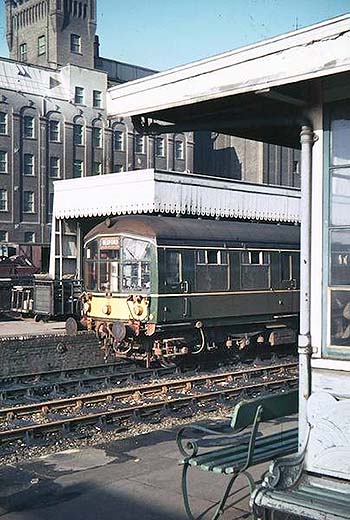 At the other end of the station in October 1967 a Derby Lightweight unit waits in platform 3; this will almost certainly be a London Midland Region unit, these being common at Cambridge along with the native Eastern Region units. The destination blind is presumed to be incorrectly set and the unit will run to either Bletchley or Oxford. Three months after the photograph was taken, the Bedford line closed. The final departure from Cambridge being operated by Derby Lightweight M79136 / M79657 with your author on-board. The run from Cambridge to Lords Bridge on one of these units could be quite lively as the DLs had a tendency to bounce at speed.
At the other end of the station in October 1967 a Derby Lightweight unit waits in platform 3; this will almost certainly be a London Midland Region unit, these being common at Cambridge along with the native Eastern Region units. The destination blind is presumed to be incorrectly set and the unit will run to either Bletchley or Oxford. Three months after the photograph was taken, the Bedford line closed. The final departure from Cambridge being operated by Derby Lightweight M79136 / M79657 with your author on-board. The run from Cambridge to Lords Bridge on one of these units could be quite lively as the DLs had a tendency to bounce at speed.
The image above also shows the shelter at this end of the station. It was identical to that seen in the previous image. The colour image gives an idea of the rather shabby state of Cambridge station at this time and Spillers Mill is only just beginning to recover from decades of steam locomotive grime. On the DMU, the 'yellow diamond' code can be seen as can the untidy jumper cables. These cables always looked more untidy on the Derby Lightweights than they did on the Metro-Cammells.
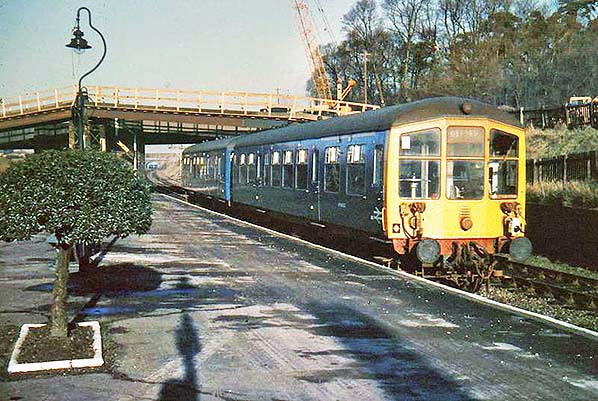
Photo (and that above) by Geoffrey Skelsey
Not the sharpest of images, above, but nonetheless a nice shot of a Derby Lightweight at Sandy on a Cambridge - Oxford service. The BR blue livery suited these units very well, especially if cab doors were also blue. Some had the yellow extended to include the cab doors and this somehow did not look quite right. We can see how the coupling code neatly made use of the yellow front end. In the cab, on the left, can be seen the handbrake wheel on a floor-mounted pillar. On the Metro-Cammells it was mounted on the drivers desk, as indeed it was on the majority of DMUs. The Derby Lightweight cab, while practical, was a little antiquated and even the drivers brake valve was not desk-mounted but instead was self-supported by its own exposed pipework.
The picture was taken in mid-December 1967, two weeks before the Varsity Line (Oxford - Cambridge) closed. Sandy station sits on a south-south-east to north-north-west axis so the shadows on the platform, working like a sundial, tell us the time is late morning. The train is therefore likely to be the 10:43 ex Cambridge which called at Sandy at 11:09. This train, at this period, called only at main stations with Sandy being the only call between Cambridge and Bedford. It arrived Oxford at 12:44. Today there is no trace of the former LNWR side of Sandy station. As the bushes on the left indicate, Sandy station was always neatly maintained and it was once a popular spot for Cambridge railway fans to spend a day, having both the ex-LNWR line and the ex-Great Northern main line passing through. The bridge under repair in the background carries Potton Road over the railway.
In the beginning the Derby Lightweights were not without their problems. To be truly lightweight a great deal of aluminium was used and in a short space of time the bodywork was found to be not up to the job and strengthening modifications had to be undertaken. The horizontal bar across the windscreens was not present on all units originally; it seems to have been applied to later units as they were built and retrospectively to earlier builds. Note the centrally pivoted windscreen wiper with a second blade covering the upper section of the windscreen. This was done to aid signal sighting at close quarters; for example a starter signal at the end of a platform for which a driver would need to look upwards. Raked windscreens such as those on the Metro-Cammells helped eliminate this problem, although the problem was probably more perceived than actual. On units without the horizontal bar the wiper was mounted at the corner of the body; a single-blade wiper which operate in a vertical arc.
Earlier we mentioned how BR and others later copied the general styling of the Metro-Cammell cab. The Derby Lightweight design cannot be said to have been unattractive but the large expanse of vertical glass caused problems for drivers as it was a source of reflections and also made the cabs unbearably hot in summer (the latter is a problem which remains to this day to one degree or another - pun unintended).
Metro-Cammell had a better idea; three smaller windscreens raked back and with a much tidier layout inside the cab thrown in. BR was most impressed and copied the principle of the design, this being the reason why all subsequent Derby-built DMUs had the three-piece raked back windscreen design. A couple of private builders also used the arrangement for their suburban-type DMUs which were built to Derby designs. Swindon works did similar but used a two-part windscreen design where cab ends did not incorporate a gangway connection.
 It has often been asked why Derby produced such an elaborate windscreen design for its 79xxx Lightweight units. The actual reason is not widely known and was a very sensible one, if not a little over-cautious. Those who remember these units or who have seen the preserved examples will know the body profile was the same at each end of individual cars. The Derby Lightweights were BR's first DMUs intended for mass production and BR took a cautious approach whereby had the units proved a failure the cars could be relatively easily converted into locomotive-hauled stock. Had this happened, the driving cabs would have been stripped and converted into vestibules, the outer windscreen sections plated over and a gangway connection fitted in the position which was originally the central windscreen section. This contingency plan by default produced the windscreen design which became these units' trademark. Turning the tables around, the same contingency plan allowed the easy construction of the two single cars M79900/1. These are believed to have been intended as driving motor cars for 2-car units but, after construction had begun, were altered into single cars. This would have entailed the simple matter of altering what would have been the gangway end into a driving cab due to the cab-end body profile already designed in. The finer details of DMUs tended to vary according to requirements of their intended operating area. For example, some areas may have specified larger vans (the brake / guards compartment). This may explain the detail differences between what emerged as single cars M79900/1.
It has often been asked why Derby produced such an elaborate windscreen design for its 79xxx Lightweight units. The actual reason is not widely known and was a very sensible one, if not a little over-cautious. Those who remember these units or who have seen the preserved examples will know the body profile was the same at each end of individual cars. The Derby Lightweights were BR's first DMUs intended for mass production and BR took a cautious approach whereby had the units proved a failure the cars could be relatively easily converted into locomotive-hauled stock. Had this happened, the driving cabs would have been stripped and converted into vestibules, the outer windscreen sections plated over and a gangway connection fitted in the position which was originally the central windscreen section. This contingency plan by default produced the windscreen design which became these units' trademark. Turning the tables around, the same contingency plan allowed the easy construction of the two single cars M79900/1. These are believed to have been intended as driving motor cars for 2-car units but, after construction had begun, were altered into single cars. This would have entailed the simple matter of altering what would have been the gangway end into a driving cab due to the cab-end body profile already designed in. The finer details of DMUs tended to vary according to requirements of their intended operating area. For example, some areas may have specified larger vans (the brake / guards compartment). This may explain the detail differences between what emerged as single cars M79900/1.
The first Derby Lightweights to be allocated to Cambridge were said to have been E79035 + E79251 and E79036 + E79252. These were put to work on Mildenhall and Ipswich services, the former being the 16:36 ex Cambridge which returned via Newmarket and the latter the 07:05 and 14:00 ex Cambridge and return.
E79035/6 and partners were not alone at Cambridge for long. Very soon a large batch was allocated to Cambridge and in due course these were joined by further sets which had begun life in the Birmingham area. Cambridge thus became something of a stronghold for the Derby Lightweights, with its own allocation plus visits by sets from other depots in the region as well as the LMR units and, of course, the Metro-Cammell Lightweights.
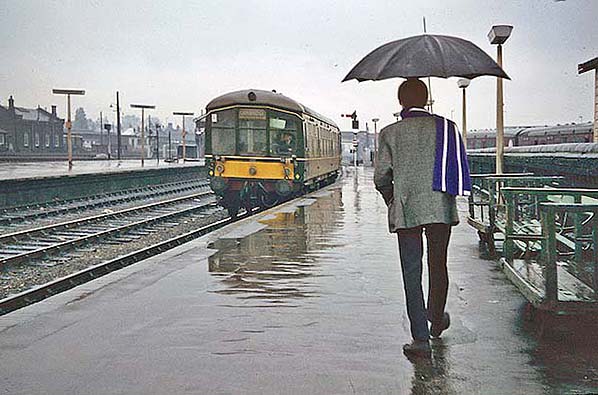
Photo by Geoffrey Skelsey
Above, on a wet spring day in 1963 we find ourselves on platform 3 in the company of a King's College student watching the arrival of a Derby Lightweight. Information with the photograph states the train has come from Oxford.
Only two or three trains per day ran through from Cambridge to Oxford, most ran to / from Bletchley. When the Cambridge - Bedford and Bletchley - Oxford passenger trains were withdrawn, it became something of an urban myth that it was quicker to travel from Cambridge to Oxford via London so the direct service was withdrawn. The truth about the Cambridge - Oxford service was that its infrequency made it more convenient to travel via London even if that did involve a tube journey to / from Paddington. In reality, apart from a few university people and a handful of tourists not many people actually needed or wanted to travel from Cambridge to Oxford or vice versa.
At the time of the above photograph trains departed Oxford for Cambridge at 7.57am (arr 10.29); 9.44am (arr 11.43); 2.48pm (arr 5.21). On Saturdays the 9.44am and 2.48pm departed Oxford at 9.37am and 2.55pm respectively. Of these, it can be seen, the slowest took around 2½hrs and these called at most stations, omitting just three or four between Bletchley and Bedford. From Cambridge to Oxford the service was similar; 10.43am (arr 12.40); 2.12pm (arr 4.53); 7.1pm (arr 9.0); 9.1pm SO (arr 10.57). Of those, the 10.43am, 7.1pm and 9.1pm called only at the main stations and even omitted Sandy in the case of the 10.43am and 7.1pm. Otherwise, trains ran between Oxford and Bletchley, Bletchley and Bedford or Bletchley and Cambridge. Given the sparse Oxford - Cambridge service it is easy to see why it was more convenient to travel via London even though it was no quicker. One could also travel between Oxford and Cambridge or vice versa by changing at Bletchley but this entailed a lengthy wait and in these cases it probably was quicker via London.
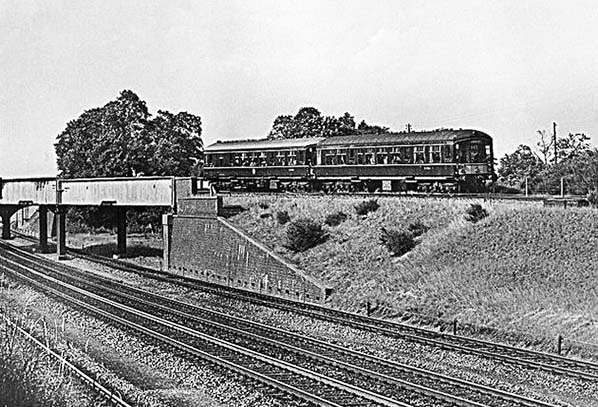
© Chris Burton
We have already mentioned the two single cars, M79900/1. After the Buckingham service was withdrawn in 1964 the two single cars became a common sight at Cambridge, sometimes coupled together and sometimes coupled to another, single-ended, car. The single-ended cars were driving motor cars made redundant elsewhere and sent to Bletchley for use with M79900/1. The three vehicles concerned did not have brake compartments so were probably ex-power-twins and were M79190/1 with a third believed to be M79189. At least one of them seems to have been de-engined and thus ran as a driving trailer. These cars had toilets whereas M79900 /1 did not. A well known photograph exists showing M79900 with one of the single-ended cars at Potton on its way to Cambridge but above can be seen M79901 on a Bletchley - Cambridge service approaching Sandy on 27 July 1966. M79901 is at the rear and the leading car appears to be a de-engined M79189 but the image is not clear enough to confirm. It is not M79190 because that is known to have faced west at this time. The train has just crossed the East Coast Main Line on the bridge rebuilt in 1957.
M79901 was withdrawn in December 1966 and is said to have been scrapped at Bletchley in April 1967. M79900 soldiered on and had survived into preservation thanks to entering departmental service as the famous test coach 'Iris'. Unfortunately 'Iris' was altered by BR into 'blue square' configuration and given Sharpes controls so part of the character of the Derby Lightweights has been lost. She also looks wrong coupled, in preservation, to 'blue square' units but at least she survived and we must be thankful for that.
One of the twin units has also survived thanks to having entered departmental service, this being ex-Cumbrian unit M79018 / M79612. Considering this unit entered preservation in much modified form and, due partly to asbestos removal, pretty much a wreck, a superb job of restoration is ongoing at the time of writing. Her cabs were also meddled with by BR but it is understood the preservationists are returning the cabs to their original form thanks to original parts being found or donated. This unit retains its 'yellow diamond' configuration but it is understood that the preservationists wish to rewire the unit into 'blue square' configuration. If this happens, like M79900 much of the character of these units will be lost however much they may look the part.
Sharp eyed readers may have noticed the Derby Lightweights had brackets for roof boards. This added luxury was also found on some Swindon-built DMUs and the Derby-built Class 108. Class 108 also appeared at Cambridge from the Bedford line. The type was also a lightweight but 'blue square' and in effect an updated version of the 79xxx Derby Lightweight. The latter, like the Metro-Cammell Lightweights, had bowed out of passenger service by 1969.
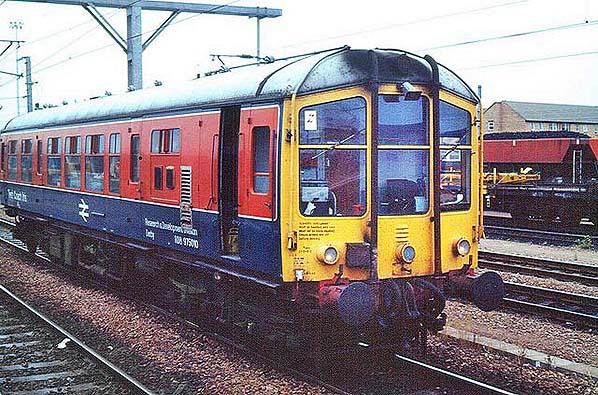
Photo
by Pat Newson from Cambridge area 1980s Flickr photostream
Above is M79901's sister, M79900, at Cambridge in September 1990 and in test coach 'Iris' form. She was later repainted into something resembling her original livery and carrying the number M79900. 'Iris' was used for general test work and testing for the RETB radio signalling system. The former guards compartment contained a diesel generator set for powering onboard equipment. Note the staining on the cab roof from the twin exhaust pipes. When 'Iris' was withdrawn and sold for preservation she was replaced by a Metro-Cammell twin set.
The Virgin Soldiers
Following withdrawal from passenger service, a few Derby Lightweight vehicles remained in departmental service but the sidings at Coldhams Lane were full of them awaiting disposal. However, on a siding immediately north of Mill Road bridge car E79253 which was a Norwich-based car when withdrawn was parked . The train used in The Virgin Soldiers film used four ex-LMS Stanier coaches which had been modified, fairly authentically, to resemble Malayan coaches. Their end vestibules had been opened up to form verandas. E79253 sat at Mill Road for quite a while and enquires regarding why revealed it was to have its windscreens and cab doors removed so it too ended up with a veranda. It was also to serve as a brake van for The Virgin Soldiers train, which was towed to Bartlow by a diesel locomotive.
However, it is unclear if E79253 was actually used as intended. There was no sign of it in the film but it is known that a brakevan of some sort was attached to the train.
At the time the film was made, incidentally, the livery of Malayan Railways stock was very similar to the BR 'blood & custard' and carried a 'MR' monogram on its sides. This is the livery the Stanier coaches were painted in. Malayan stock also had a central doorway, something that was not replicated on the Stanier stock. As a further point of interest, Malayan Railways are metre gauge and had some English Electric diesel shunters which looked suspiciously similar to the British Class 11. Black 5 44781, used in the film, was numbered 531.03; this was an authentic number but the real 531.03 was a 4-6-2 with 8-wheel tender and built in Leeds by Kitson & Co. It was originally Federated Malay States Railways 216 and as such had served, with four others, during the Japanese occupation on the infamous Burma Railway. All five survived the war and were returned to Malaya where they continued in service until the early 1970s.
The Waggon und Maschinenbau Diesel Railbuses
Not multiple units but due to their 79xxx number series it is convenient to mention the railbuses in this section.
BR ordered 23 four-wheel diesel railbuses from five manufacturers, 22 of which were for passenger services. Four manufacturers built five passenger railbuses each, with Bristol / ECW building two. The odd man out was a sixth Wickham vehicle built for departmental service.
The idea of the railbuses was to cut losses on rural branch lines; this they did insofar as their own running costs were concerned but little, if anything, was done to reduce other costs such as staffing levels on branch lines. All the railbuses were second-class only, had no toilet and could not accommodate the wide range of goods which rural people were used to loading into the brakes of proper trains. When this problem arose another train, often a diesel shunter with one or two vans, had to be sent to collect the goods the railbuses had had to leave behind. This, of course, should have been foreseen and it rather rendered the railbuses pointless.
Cambridge was lumbered with the five German Waggon und Maschinenbau railbuses. They were based on the German VT95 (original classification) Uerdingen railbus (in German, Uerdinger Schienenbus) which had been widely and successfully used in Germany; at the time of writing some remain in service on minor railways with others hired in by Deutsche Bahn from organisations to which they had once been sold off. However, the Uerdingen railbuses differed to the BR examples in many ways.
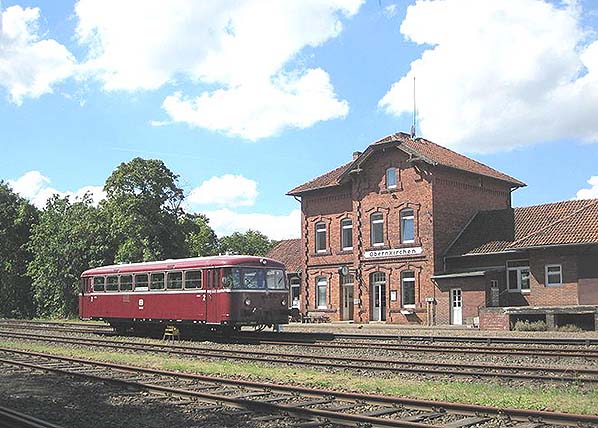
Photo by Stefan Flöper reproduced from Wikimedia Commons under creative commons licence
Above is one of the Uerdingen railbuses at Obernkirchen, Germany, in August 2012.
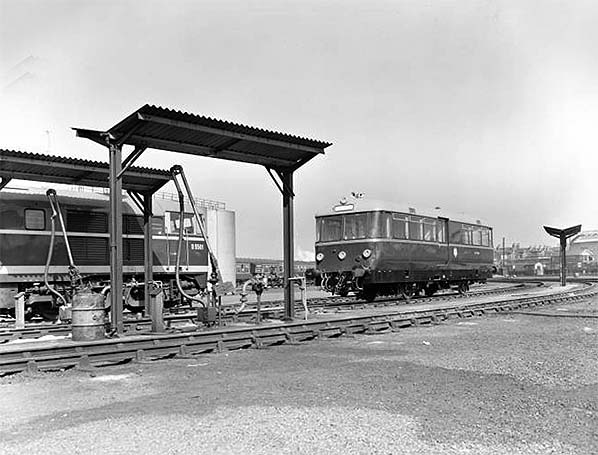
© National Railway Museum and SSPL
Above, on 1 April 1958 we see one of the BR German railbuses at Stratford in the company of a Brush Type 2. The two images above show some similarities but also the major differences. The drivers desk was near identical on both types, as was the running gear but otherwise the BR examples were very much anglicised and were, of course, to British loading gauge. There is some evidence that the latter was just about the only requirement of the BTC when it placed the order for what was to be E79960 - 4 and that the specification was much altered after the order had been placed. Seating arrangement, central door and driver separated from passengers in a small cab on the left at each end being among the changes. In Germany it was not considered necessary to place the driver in a cab. One cannot help wondering if the BTC ordered the railbuses hastily and blindly without giving the VT95 any sort of prior detailed examination. This is quite possible because the BTC laid down a very basic set of specifications but otherwise left manufacturers with very much a free hand and this did not only apply to railbuses.
Some of the other types of BR railbus were fitted with virtually standard DMU controls and power trains but E79960 - 4 came with equipment which was very much of the German standard. Büssing 6-cylinder horizontal engines were fitted together with a ZF six-speed electro-pneumatic gearbox. The throttle was a foot pedal as per road vehicles. Braking was air operated discs, rare in Britain at that time, and a ratchet, road vehicle type, parking brake was fitted. Under the drivers desk was a lever for changing direction and a foot-operated bell, or gong, was fitted. Air horns were roof mounted and of an unusual triple-tone type. They were known, apparently, as Typhoon horns whereas the standard BR two-tone horn was the Desilux type.
E79960 - 4 differed to BR's other passenger railbuses in that they were fitted with conventional buffing and drawgear together with the necessary connections to permit two to be coupled together. However, they could not operate in multiple with one driver up-front; the limit was one towing another as a trailer with the leading railbus operating the brakes on both. In theory they could also tow a van of up to a certain tare weight, probably 10 tons, but in practice a van would have to be air braked and BR had largely standardised on the vacuum brake. In any event, the railbuses appear to have only been compatible with themselves with regard to the connecting pipes.
The first two Waggon und Maschinenbau railbuses arrived in Britain via Zeebrugge and went to Stratford but dates are not entirely clear. The first two are generally acknowledged as being E79960/1. E79961 was apparently sent to Liverpool Street o April 1958 for the customary inspection by the 'brass' but a photograph exists showing E79960 at Stratford on 17 April, supposedly newly delivered and with posters in the windows claiming it had come from Brown Boveri, Mannheim. This is said to have intended to divert attention from the fact the railbuses were German, this being only 13 years after the end of WWII, but the name Mannheim in large bold letters rather gave the game away. Brown Boveri were a Swiss firm with a subsidiary in Mannheim but the railbuses were actually built at Donauworth, Germany.
The first two railbuses were soon afterwards sent to Cambridge and it is said the remaining three were delivered direct to Cambridge, yet a photograph exists of E79962 at Stratford on 17 May 1958. That is, of course, assuming the caption is correct - the railbus number is not actually visible in the photograph.
The story goes that E79960 - 4 were originally intended to be based at Stratford but a last minute change of plan saw Cambridge lumbered with them. This change is said to have come about in order to reduce the amount of light mileage but the original railbus diagrams meant there would have been little difference no matter which depot they were allocated to. The one service that does not fit this deduction is the Mildenhall branch but railbus use on this service seems to have came about because the railbuses were sent to Cambridge rather than why. Clearly, the Mildenhall branch had been intended for DMUs and as things turned out many Mildenhall services, via both Burwell and Newmarket, were operated by DMUs. One exception was the first service from Cambridge each morning; as part of the cyclic diagrams this railbus returned from Mildenhall as a through service to Chappel, or Marks Tey, via the Colne Valley Line. It then ran empty to Witham to take up duty on the Maldon branch. The relieved railbus then returned to Cambridge for maintenance via the same route. This complete, Cambridge depot then had a spare railbus which might have operated another turn to Mildenhall or replaced a failure somewhere. The Braintree branch, incidentally, was too busy for the railbuses to cope and was soon turned over to DMU operation and this effectively left another railbus spare.
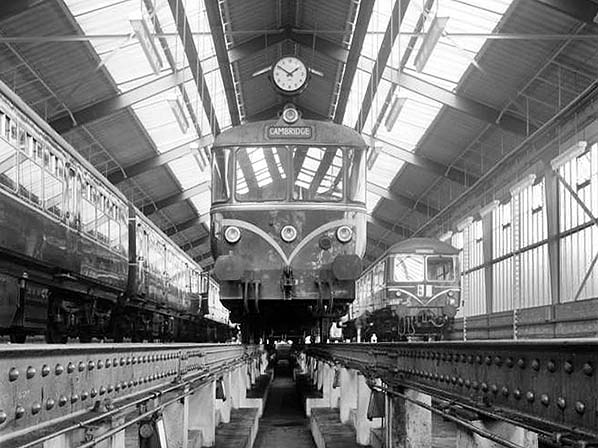
© National Railway Museum and SSPL
Taken on the same day as the earlier Class 03 photograph, 5 March 1959, a diesel railbus is seen inside Cambridge diesel depot. On the right is a Cravens unit and on the left one of the rare Wickham units. The railbus is thought to be E79961, which was to go on to be the only one of the five not to survive, having been scrapped by C.F.Booth, Rotherham, c1967. Original livery was a lighter shade of green which looked rather faded. They were soon repainted in the more familiar darker shade and given 'whiskers' as seen above. A photograph exists, albeit it black and white, of one of the railbuses in Germany when brand new. Its green paint appears somewhat darker and richer which may suggest the original paint, applied in Germany, simply did not wear very well.
As has been mentioned, photographs of railbuses at Cambridge station have proved elusive. There is one of E79960 in Evan Green-Hughes book BR First Generation Diesel Railbuses captioned as being taken at Cambridge shed on 4 July 1963. Whilst shed is technically correct, the railbus is actually on what later came to be known as 'the dump'. Quite why it was dumped on 'the dump' is hard to say but perhaps it was waiting for a road to be cleared at the diesel depot.
Like all the railbuses, the German examples had their problems but perhaps not as horrendously as one is led to believe and they eventually settled down as staff familiarity increased. Three had their Büssing engines replaced by AEC 220 units but this was no reflection on Büssing; they were very good engines but the problem appears to have stemmed from the importing of spare parts - Import Duty having been increased by 10% around the time the railbuses were introduced. There may also have been a problem, or a perceived problem, with British engineers working with metric dimensions.
One very real problem was that the railbuses could not be relied upon to operate track circuits and this required special rules to be enacted when they ran on main lines - which they did; Audley End or Shelford Junction - Cambridge; Cambridge - Barnwell Junction; Marks Tey - Witham.
As Cambridge depot lost work for the railbuses, some were sent away for trials elsewhere. By 1967 all were back at Cambridge, withdrawn, and the 'wagon bashers', as enthusiasts came to call them, were for a short while a familiar sight from passing trains lined up adjacent to the storage tanks outside Cambridge diesel depot.
Like all the railbuses, ride quality left a lot to be desired but this, it must be remembered, was in comparison to bogie stock. The ride was not necessarily as dreadful as anecdotes love to make out but much of it depended upon the track. On the Mildenhall branch they were known to be prone to excessive pitch and yaw but on other lines they were fairly acceptable - for short journeys anyway. The one endearing memory of them was the monotonous thump thump - thump thump - thump thump on jointed track. But the Waggon und Maschinenbau railbuses were fitted with curtains and this refinement gave an illusion of luxury travel - an illusion which was often soon shattered once the journey was underway.
No doubt the railbuses were ordered with every good intention but, as said earlier, it is hard to see how BR could really have expected them to be a success. A much better idea would have been the ordering of larger batches of the single-car DMUs, later Classes 121 and 122. Costs would have been higher but at least this type of railcar would not have discouraged business as the 4-wheel railbuses are claimed to have done in some cases. Often described as 'too little, too light, too late', the railbuses had amusement value if nothing else. Of those which entered preservation, some have now served their heritage-owners four times as long as they served BR, including one still with a Büssing engine, and it is interesting to note that in Germany and, now, other European countries some of the Uerdingen units are still going strong.
Why The 79xxx Number Series?
In Part 5 we covered the BR Standard steam locomotives and noted their number series began at 70000 and ended with 92250 but there were gaps; for example the 74000, 79000 and 83000 series were not used. It had been planned to build more Standard steam locomotives, in which case the absent number series would have been used, depending on types built. However, the 1955 Modernisation Plan brought a halt to steam locomotive building with the final example being 9F 92220 in 1960. When the 79xxx DMUs were in the planning stage it was simply convenient to number them in a motive power sequence which happened to be vacant and that, of course, was 79000 - 79999. The earlier ACV railbus trains, the 'flying bricks', had also been numbered in this series, using the 797xx range of numbers.
Similarly, certain types of car in BR-built electric multiple unit car also took numbers which would have been used for an expanded number of Standard steam locomotives.
The whole thing therefore raises the question of when exactly it was decided to order no further Standard steam locomotives. It must have been prior to 1954, when the first Derby Lightweights appeared. The original 'flying brick' set comprised three four-wheeled vehicles and as they were privately owned when introduced in 1952 the cars were numbered simply 1 - 3. BR purchased this set in January 1955 (and ordered further examples) which was when they were renumbered in the 797xx series. This, then, ties-in nicely with a pre-1954 decision to abandon steam locomotive building and implement the 1955 Modernisation Plan.
The 'blue square' 5xxxx types
As we have seen, the 'blue square' units were to become the predominant DMU type across all of BR except the Southern Region. The 'blue square' configuration gave better control of equipment throughout the train and the wiring was also somewhat simpler. The first 'blue square' units appeared as early as 1956 and over the following five or so years literally thousands of cars were built, both by BR and by private industry. Metro-Cammells offerings retained a very similar outward appearance to their 79xxx units, perhaps indicating the soundness of the original design, the fundamentals of which, as we know, BR took onboard with their post 79xxx designs.
Countless types of 'blue square' DMU appeared at Cambridge, with services from places such Birmingham, Doncaster and Sheffield bringing types which were otherwise alien to the region. Even Tyseley-based suburban units could turn up on occasion, although Cambridge was familiar with Suburban DMUs in later years as some operated from King's Cross.
It would be impractical to describe all types relevant to Cambridge in any detail, so we will adhere to just a few types beginning with the Cravens units as these were a local speciality.
The first of the Cravens appeared at Cambridge shortly after the Derby Lightweights. Several of the 'blue square' classes were also lightweights and this included the Cravens, or Class 105 6 as they were to become. There were other types of Cravens units, including some with hydraulic transmission and Rolls-Royce engines, a batch of 3-car units and three motor parcels vans which were of the 'yellow diamond' configuration. Class 105 had AEC engines and 106 had Leyland engines albeit both BUT branded. There was also Class 112; power twins with a single Rolls-Royce 238bhp 8-cylinder engine per car and standard mechanical transmission. Two of these are said to have somehow found their way to East Anglia in the mid-1960s, one at Cambridge and the other at Norwich. However, despite the existence of a photograph claiming to show one of them at Thurston on an Ipswich - Cambridge service, no conclusive evidence of their East Anglian penetration has yet come to light.
A batch of Cravens was allocated to Cambridge for East Anglian services and these were later transferred to Norwich due to divisional changes in 1971 although operations continued much as before. In time, these changes proved to be a mistake as Norwich was too far away to have its finger on the button regarding local goings-on at Cambridge. Meanwhile, yet more Cravens had arrived at Cambridge for King's Cross suburban services, these units were said to have been intended for the M&GN but closure of most of that system in 1959 had rendered them superfluous. The reason the Finsbury Park Cravens, as they came to be known, were actually sent to Cambridge will be explained later.
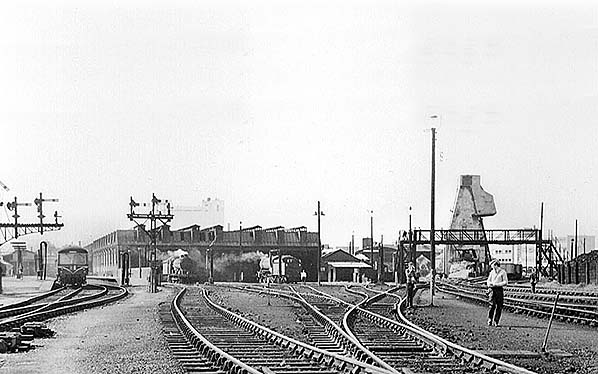
Photo by Geoffrey Skelsey
When DMUs first appeared at Cambridge, steam was still alive as the atmospheric image above shows. The date is 4 September 1960 and there appears to be a shed visit going on. The footbridge gave access to the shed from Devonshire Road but it always seemed rather pointless because a) it did span all the tracks and b) railway staff were permitted to simply walk across the tracks anyway. The bridge was, however, handy for enthusiasts to view the shed from and although the bridge was officially only for staff nobody bothered.
On the left, the station provides some interesting contrasts. The fluorescent lighting is in place, the impressive signal bracket and water cranes are visible but upper quadrant signals stand sentinel at the end of platform 6. A Cravens DMU awaits clearance to leave platform 5, presumably on its way to the diesel depot as a guard of a train in passenger service would not have given the starting signal against a signal at danger. On the far left we can see the signal is off for a train to depart platform 4 - hence the DMU is being held. The Cravens unit is one of a later batch with two-character headcode panel. One of the blinds appears to wound onto a white blank and this seems to have been common practice at the time. Later the headcode B2 was often displayed and apparently just left on that setting regardless. B2 indicated a stopping or local service and corresponded to a single white disc in the upper position on a steam locomotive. Other DMUs had four-character displays and displayed the headcodes relevant to the service being operated in the same way that locomotives so-fitted did.
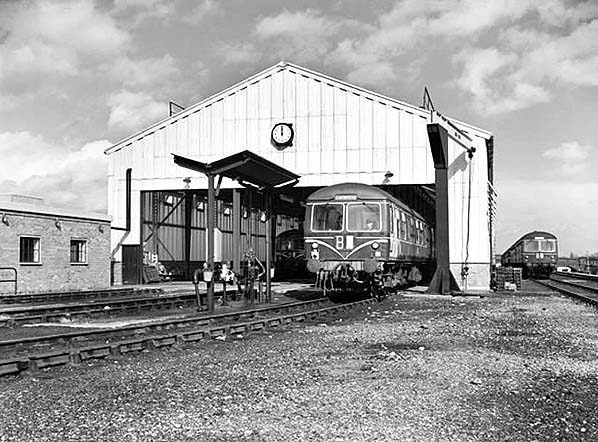
© National Railway Museum and SSPL
Above, again taken on 5 March 1959 we see three sets of Cravens DMUs at Cambridge diesel depot. These views of the depot, including that of the Class 03 undergoing maintenance, are suspected of being deliberately posed for the camera of a BR photographer. The depot had, as can be seen, just three undercover roads but it was a very lengthy building - and still is - due to being designed for strings of DMUs rather than locomotives. The sidings on the right later had a lean-to structure added at the far end and were to become something of a dumping ground for shunters, odd DMU cars and other items of rolling stock.
The Cravens DMUs, together with certain of the Swindon-built units, were unique on BR for having two-piece windscreens. This gave them a tidy, but somehow antiquated, frontal appearance. The 'blue square' coupling code can be seen on the nearest unit above and as most Cravens were lightweight units the letters LW were generally stenciled onto the blue square. The bodies were to BR Mk1 stock profile and several other fittings were common to Mk1 stock, including the doors with the exception of having a sliding latch on the inside. This was common to most if not all DMUs and many suburban EMUs and was also found on the non corridor locomotive-hauled stock. Another feature of the Cravens was the sloping drivers desks which made the driving position a little more comfortable. One other feature unique to Cravens was the exhaust pipe; the two engines shared a common exhaust outlet section which passed, suitably insulated, through the brake compartment to exhaust through the roof. Most DMUs were famous for the loud rasping sound from the exhaust at high engine revs but Cravens beat the lot by a significant margin. In later years some were given better silencing arrangements mounted on the inner end adjacent to the gangway connection in the manner of almost all other DMUs. Anybody who lived within a mile or so of Cambridge depot while Cravens were in residence will remember well the almighty rasps as they were started up in the still air of early mornings.
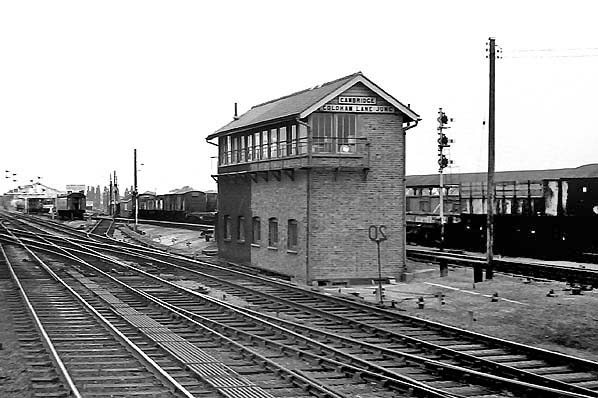
Photo by Alan Brown
Above, in January 1970 we see the diesel depot in the distance and Coldham Lane Junction box in the foreground. The signals seen in the left background are the same ones as seen in the 1948 image of Class 04 E3913 in Part 5. When the diesel depot was built, the route being taken by the Class 04 became no longer possible due to the necessary track alterations. The signal box was extended when the depot was opened, hence the obvious change in the brickwork. The (flat bottom) track on the left is the up main and the two tracks between that and the box are the down and up Newmarket. Today, the Newmarket line is single track and the junction is further north near Coldhams Lane bridge. To the right of the depot a Cravens DMU can be seen and just outside the depot is what appears to be a Class 25 diesel locomotive. Closer to the camera stands a single DMU car. Through 1969 a number of withdrawn Derby Lightweight DMUs were still lingering but by the time the photograph was taken they had all gone. Readers are reminded that 'Coldham Lane' is railway spelling while the actual road is named 'Coldhams Lane'.
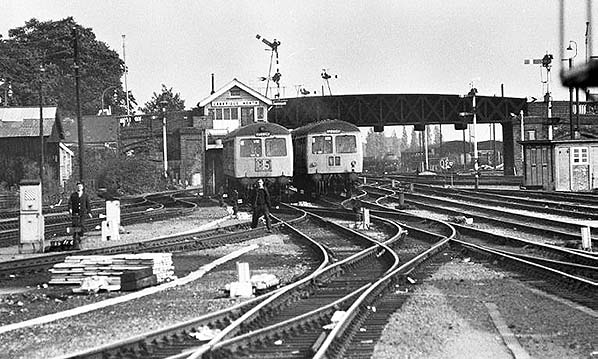
Photo
by David Burrows from his Flickr photostream
More Cravens, above, in 1976 at Cambridge North. The unit on the right has just rasped out of platform 5 on its way to Ipswich. A couple of minutes later it will squeal round the curve onto Coldhams common and then rasp again as it climbs up the gradient towards the bridge over Coldhams Lane. The unit on the left, displaying an unusual headcode, has just been stabled between services to presumably get it out of the platforms. The north end signals had all gone upper quadrant by this time. The tracks in the foreground lead to platforms 5 and 6 while those on the left lead to 'the dump'. Note the two ground signals just left of the stabled DMU; the nearest signal to the camera has an unusual arm but what this indicated is not known. The image was apparently taken using a telephoto lens so distances appear shorter than they actually are.
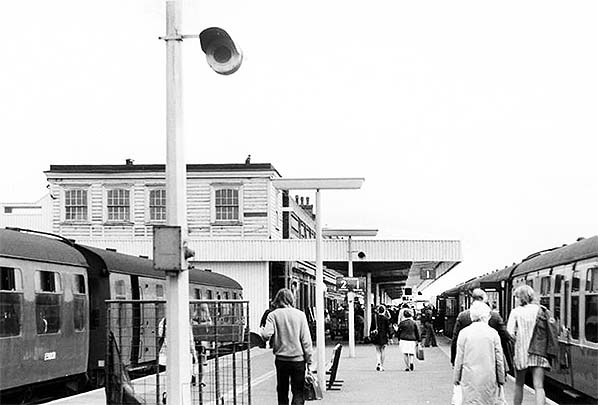
Photo by John Mann
July 1972 and, above, we find ourselves on platform 1 at a busy time of day. The train on the right will be either to or from Liverpool Street and going either to or from King's Lynn or Norwich. Cravens are sitting in platform 2 on a King's Cross service. Note that the fluorescent lamps have been de-named and some enamel signs still exist to point the way. At this time Cambridge station was a mix of the old, the not so old, the scruffy, the not so scruffy ........ and Cravens. Oh yes, and BRUTE trolleys existed in abundance. BRUTE = British Rail Universal Trolley Equipment. They could even be loaded aboard Cravens if the mood was so inclined.
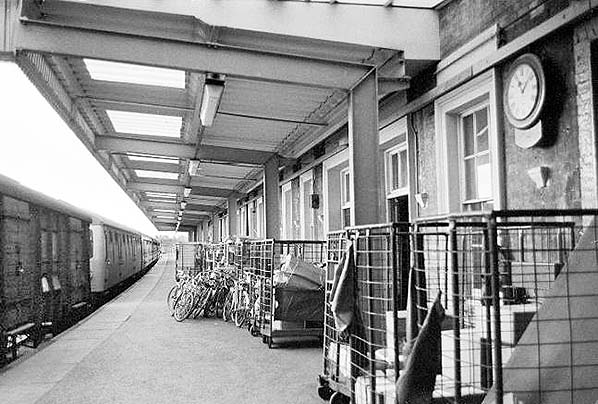
Photo
by David Burrows from his Flickr photostream
Above is a view south along platform 1 in July 1976. Plenty of BRUTE trolleys are in evidence and back in 1845 trains ran where the photographer is standing and the BRUTE trolleys occupy what was once the narrow original platform. On the wall can be seen a lovely English drop-dial clock, or rather it was once a lovely English drop-dial clock; it had been totally ruined by a crudely executed conversion into synchronous electric form. In ruined form it was supplied with power from the conduit running above it. Synchronous clocks use the frequency of the AC mains supply to keep time and are extremely accurate, especially today with power station outputs accurately regulated.
Note the conglomeration of bicycles. These could also be loaded onboard Cravens, a set of which just happens to be at the platform. It is not clear if the van is coupled to the DMU but DMUs towing vans were once a not uncommon sight. Two regular such workings involved a Sunday afternoon service from Bletchley and return and a Sunday afternoon service from Ipswich. That on the Bletchley line ran until the Sunday service was withdrawn in 1966 while that from Ipswich was to become the very last such regular working on British Rail, as British Railways came to be named from 1965, and operated until 1984. It was usually a 3-car DMU, either a Metro-Cammell Class 101 or a BRCW Class 104. Despite the switch of goods to road transport and the commodious brake compartments of DMUs, there was still a requirement for the extra capacity of a van on some services. It was also not uncommon to see a van of one type or another arrive at Cambridge from King's Cross coupled to a passenger train, as we saw in the picture taken at Hadley Wood.
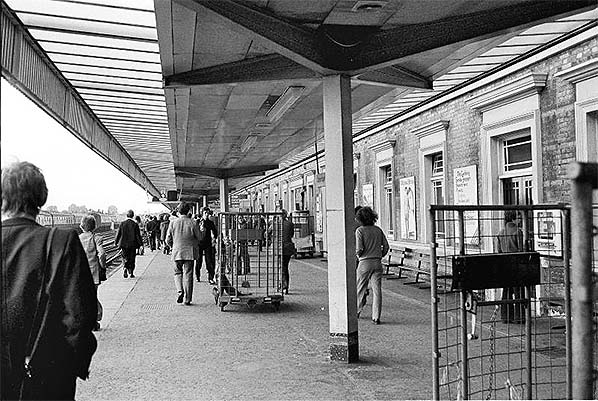
Photo
by David Burrows from his Flickr photostream
Taken at around the same time as the previous image and convenient to show here, above is the scene from the south end of platform 4 and looking south. BRUTE trolleys are again in evidence but not in quite such large numbers this time. On the right an example of the once ubiquitous Nestles chocolate machines can be seen, with a young lad deciding on his choice - or wondering how to obtain a bar without paying. In those days Nestles was still pronounced 'Nestles'; this being before the time we were supposed to start pronouncing it 'Nestlay'. Whatever next.
On the wall in the distance the sign for the 'Out of Town Buffet & Bar' can be seen. This was the only surviving station buffet by this time and was on the site of one of the two original refreshment rooms. Travellers Fare, the then catering division of BR, named its station buffets appropriate to their location. At Cambridge the buffet name was a nod to the fact the station was some way from the city centre. At other stations, buffets were named after local historical figures, rivers, ancient monuments and so on. Railway enthusiasts of the time would, on their travels, note the names of station buffets. Silly it may well have been but it was harmless and today such things have become part of station history.
The signal seen beneath the canopy is CS12, which tells us it is controlled from Cambridge South box. It had replaced the lower quadrant bracket signals guarding the scissors crossing which in turn had replaced those once controlled by Cambridge Central box perched up on the roof.
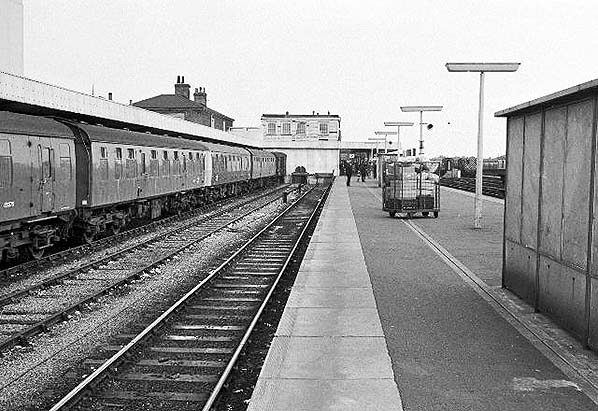
Photo
by David Burrows from his Flickr photostream
The above view of the south bay dates from 1976 and is thought to be May of that year. By this time the blue enamel platform signs have been replaced by the clinical BR black and white types (BR's Corporate Image'. On the right the ghastly bus shelter type structure which had eventually replaced the equally ghastly wooden structure can be seen. Another such shelter can just be seen nearer the canopy. A well loaded BRUTE trolley waits on the platform. A Class 08 shunter can be seen in the right background. In the bay, the centre road is still in situ but appears disused. It was removed in preparation for electrification. A Cravens unit sits in platform 3, no doubt awaiting departure to King's Cross.
Although allocated on paper to Finsbury Park, the units used on King's Cross suburban services were maintained at Cambridge, so the diagrams were arranged to start and finish at Cambridge which meant that in effect the units were Cambridge based and this remained the case for their entire career rasping through the eleven tunnels between King's Cross and Cambridge. Being lightweights, the Cravens one redeeming feature on suburban work was their relatively good acceleration and braking characteristics. Otherwise they were totally unsuited to this work; each car had only two single-leaf passenger doors per side, seating was of the low density type, when two or more sets ran together - as they usually did - unused driving cabs wasted space as did the commodious brake compartment in every 2-car unit. At least each 2-car unit had a toilet; the 'block ender' non corridor locomotive hauled stock had just one per six coach rake and this was only accessible from the vehicle in which it was located while the inner suburban 'block enders' had no toilet at all.
The King's Cross suburban Cravens generally ran in 4-car sets but 6-car sets were also quite common. Despite their drawbacks for suburban work, the Cravens units rasped, rattled and vibrated perfectly successfully for two decades and failures were rare.
Apart from the MK1 corridor and 'block ender' sets, King's Cross suburban services also had a number of Class 116 suburban DMUs. These had been transferred from the Western Region as part of a BR plan to operate all King's Cross - Cambridge services by DMUs but it is not clear if this was to include the 'Buffet Express'. It probably was as the idea was to eliminate locomotive positioning movements in the King's Cross suburban side (platforms 9 - 11) and also at Moorgate. In the event it did not happen, supposedly due to insufficient DMUs being available, so things continued much the same as always until electrification. Today, most Cambridge trains still use the suburban platforms at King's Cross although due to platform lengths trains longer than eight cars have to use the main station - platforms 0 - 8. No trains to or from Cambridge, however, use platform 9¾ at King's Cross as that is reserved for a very special service to Scotland which uses a red ex-GWR steam locomotive.
Click here to continue Part 7:
British Railways the Diesel Era




 At the other end of the station in October 1967 a Derby Lightweight unit waits in platform 3; this will almost certainly be a London Midland Region unit, these being common at Cambridge along with the native Eastern Region units. The destination blind is presumed to be incorrectly set and the unit will run to either Bletchley or Oxford. Three months after the photograph was taken, the Bedford line closed. The final departure from Cambridge being operated by Derby Lightweight M79136 / M79657 with your author on-board. The run from Cambridge to Lords Bridge on one of these units could be quite lively as the DLs had a tendency to bounce at speed.
At the other end of the station in October 1967 a Derby Lightweight unit waits in platform 3; this will almost certainly be a London Midland Region unit, these being common at Cambridge along with the native Eastern Region units. The destination blind is presumed to be incorrectly set and the unit will run to either Bletchley or Oxford. Three months after the photograph was taken, the Bedford line closed. The final departure from Cambridge being operated by Derby Lightweight M79136 / M79657 with your author on-board. The run from Cambridge to Lords Bridge on one of these units could be quite lively as the DLs had a tendency to bounce at speed.
 It has often been asked why Derby produced such an elaborate windscreen design for its 79xxx Lightweight units. The actual reason is not widely known and was a very sensible one, if not a little over-cautious. Those who remember these units or who have seen the preserved examples will know the body profile was the same at each end of individual cars. The Derby Lightweights were BR's first DMUs intended for mass production and BR took a cautious approach whereby had the units proved a failure the cars could be relatively easily converted into locomotive-hauled stock. Had this happened, the driving cabs would have been stripped and converted into vestibules, the outer windscreen sections plated over and a gangway connection fitted in the position which was originally the central windscreen section. This contingency plan by default produced the windscreen design which became these units' trademark. Turning the tables around, the same contingency plan allowed the easy construction of the two single cars M79900/1. These are believed to have been intended as driving motor cars for 2-car units but, after construction had begun, were altered into single cars. This would have entailed the simple matter of altering what would have been the gangway end into a driving cab due to the cab-end body profile already designed in. The finer details of DMUs tended to vary according to requirements of their intended operating area. For example, some areas may have specified larger vans (the brake / guards compartment). This may explain the detail differences between what emerged as single cars M79900/1.
It has often been asked why Derby produced such an elaborate windscreen design for its 79xxx Lightweight units. The actual reason is not widely known and was a very sensible one, if not a little over-cautious. Those who remember these units or who have seen the preserved examples will know the body profile was the same at each end of individual cars. The Derby Lightweights were BR's first DMUs intended for mass production and BR took a cautious approach whereby had the units proved a failure the cars could be relatively easily converted into locomotive-hauled stock. Had this happened, the driving cabs would have been stripped and converted into vestibules, the outer windscreen sections plated over and a gangway connection fitted in the position which was originally the central windscreen section. This contingency plan by default produced the windscreen design which became these units' trademark. Turning the tables around, the same contingency plan allowed the easy construction of the two single cars M79900/1. These are believed to have been intended as driving motor cars for 2-car units but, after construction had begun, were altered into single cars. This would have entailed the simple matter of altering what would have been the gangway end into a driving cab due to the cab-end body profile already designed in. The finer details of DMUs tended to vary according to requirements of their intended operating area. For example, some areas may have specified larger vans (the brake / guards compartment). This may explain the detail differences between what emerged as single cars M79900/1.














 Home Page
Home Page